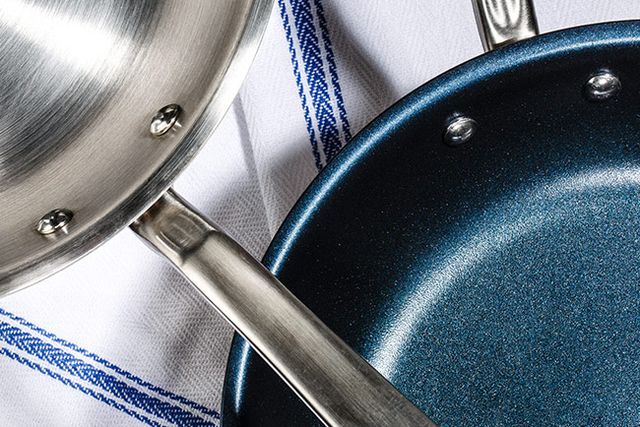Earlier this year, I sat and watched my friend Heather prepare breakfast for a host of other friends, with plans to make, among other things, hashbrowns. She shredded potatoes into beautiful little strings and proceeded to pull out a hefty non-stick pan from a cabinet under her sink.
Somewhere, cooking professionals, instructors, an armada of angry internet commenters and one Jake Kalick cried out in pain.
Kalick — cofounder of direct-to-consumer cookware company Made In — is intent on prying non-stick pans from the clutches of ‘one pan, one love’-types. His position is simple: “You can’t only use stainless steel or only use non-stick and expect the good results. They’re made with entirely different purposes in mind.”
Those purposes are spelled out in the very anatomy of the two pieces. If you were to take a microscope and zoom in on a stainless steel pan, or really any pan that isn’t non-stick, you’d see multitudes of tiny crevasses. When the pan is heated those crevasses expand and are filled by cooking oil and the food itself, making that food solidify and begin to grab hold of the pan. During the cooking process, the food itself will shrink, releasing it from the pan.
Conversely, a non-stick coating shields the food from those crevasse-ridden, heat-warping surfaces, and thereby allows it to move freely around the cooking area. This is the source of the magic that is watching your fried eggs gracefully slide around a non-stick cooking surface. It’s also why a non-stick cooking surface will fail to create a quality Maillard reaction in your cooking. The coating significantly lowers the R-value of the pan, making it lose heat dramatically when you put anything in it. The result is a surface too low-temp to dehydrate excess moisture from food.
This is not to say non-stick skillets are without place or purpose. For one, they allow for little to no oil or butter, lowering fat and calorie intake in a very real way. You can also throw easy cleanup to non-stick, as its very nature makes a rinse and wipe the most you’ll have to do. Certain foods also lend themselves to the cooking surface; Kalick provides the following suggestion: any delicate fish (think flounder or rainbow trout), egg dish that asks the egg to come out cleanly, crepe, pancake or food where a browning is not the desired outcome. All other foods, however, should have you reaching for stainless steel.
Variation between the two surfaces becomes greater the more you dive into the cookware industry. Cooking experiences change depending on the ply count, material type and quality of the metal-sourcing from company to company.
Made In uses a five-ply pan design (ply meaning layer) that creates what amounts to a metal sandwich. The top and bottom are both stainless steel, providing a non-reactive cooking surface, the trademark shiny look, but rather below-average heat conductivity. The second and fourth layer are aluminum, a fairly popular cookware material in its own right, which solves the steel’s problem by heating the pan faster by way of higher thermal conductivity. The middle layer is aluminum alloy, bringing more thermal conductivity (other companies may use all steel, or up the ante and use a copper core, like much of All-Clad’s cookware). Made In’s non-stick pieces are made in this same method, with a proprietary non-stick treatment applied to the cooking surface at the end.
“Home cooks are more educated than ever, with people spending $25 on grass-fed steaks at butchers and shopping for produce at Whole Foods and farmers markets,” Kalick says, “but there’s still this knowledge gap of not always using the best tools for the job, so that is the job, get people to that next step of understanding the tools of the trade.”
A cook is as only as good as his or her knowledge and, by extension, the gear they employ. By this point, if your knowledge leads you to cook hash browns in a non-stick pan, consider yourself early in your culinary journey. At the end of the day, nobody is clamoring for a damp mess of shredded potato.

















